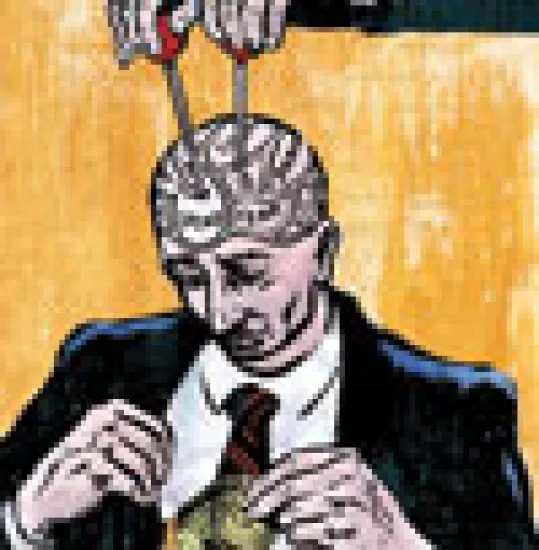The failure of mainstream economists to predict the global financial crisis provides an opportunity for exponents of behavioral finance. The crisis, they say, can be attributed to our psychological makeup. The downturn inevitably followed from the excess of confidence in the preceding boom. Yet while behavioralists provide a useful counterweight to orthodox views of economic rationality, their theory of boom and bust lacks substance — and their proposed cure would exacerbate the disease.
In their new book, Animal Spirits: How Human Psychology Drives the Economy, and Why It Matters for Global Capitalism , professors George Akerlof of the University of California, Berkeley, and Robert Shiller of Yale University propose a behavioral explanation of the business cycle. They take their cue from a passage in The General Theory of Employment, Interest, and Money , in which John Maynard Keynes suggested that investment decisions "can only be the result of animal spirits — a spontaneous urge to action rather than inaction, and not as the outcome of a weighted average of quantitative benefits multiplied by quantitative probabilities."
Keynes was not the first to allude to such forces in the financial markets. In 1870, James Medbery in Men and Mysteries of Wall Street described the "spontaneity and effervescence of animal spirits" on display at the New York Stock Exchange. Earlier economists had also emphasized the role of psychology. For instance, the 19th-century economist W.S. Jevons contended that "periodic collapses are really mental in their nature, depending upon variations of despondency, hopefulness, excitement, disappointment and panic."
In 1927, in Industrial Fluctuations , A.C. Pigou, Keynes’s University of Cambridge contemporary, argued that the business world was affected by a "psychological reflex from the actual experience of good or bad fortune, good fortune breeding errors of optimism, bad fortune errors of pessimism." Pigou maintained that at certain times the world of business was affected by "a quasi-hypnotic system of mutual suggestion." However, he concluded that psychological factors played only a minor contributory role in the business cycle itself. Later Keynesians also discounted the importance of animal spirits.
Akerlof and Shiller beg to differ. "Animal spirits," they boldly maintain, "are the main cause why the economy fluctuates as it does. They are also the main cause of involuntary unemployment." But what do they mean by "animal spirits"? Akerlof and Shiller point to a "restless and inconsistent element in the economy. It refers to our peculiar relationship with ambiguity and uncertainty." Sometimes we are paralyzed by it; other times we are energized by it.
Changes in confidence lead to shifts in the valuations of both equities and real estate, according to this view. When our animal spirits are high, we pay more for stocks and houses, and investment increases. In times of panic the collapse of confidence causes the credit markets to dry up. When confidence reaches an extreme low, it renders monetary and fiscal measures ineffectual.
Akerlof and Shiller suggest that other irrational forces are at work to prolong the downturn. Employees are reluctant to take wage cuts even when prices are falling and their real incomes are rising. They suffer from the "money illusion," a tendency to evaluate incomes in nominal rather than real terms. This is reinforced by a sense of fairness. Forced reductions in income are seen as unfair by both management and employees. Rising real wages after a bust depress profits, while low confidence makes businesses reluctant to invest.
Akerlof and Shiller ar–gue that authorities can stabilize animal spirits during a downturn by facilitating the flow of credit. The current crisis, they say, is not the result of insufficient demand in the economy but stems from the lack of available credit; if credit falls below "normal levels," full employment cannot be achieved. Recovery can be promoted by the authorities setting targets for the growth of private sector credit. Akerlof and Shiller support the measures undertaken by the Federal Reserve Board to get credit flowing again.
There is no doubt that confidence shifts over the cycle. However, this observation is not exactly novel. In 1837, Lord Overstone, a British banker, identified the stages in the cycle as quiescence, improvement, growing confidence, prosperity, excitement, overtrading, convulsion, pressure, stagnation, distress and then quiescence again. Yet Overstone was no behavioralist. He belonged to the school of thought that held that booms and busts resulted from the overextension of bank credit.
Akerlof and Shiller’s explanation of the current crisis is thin. They applaud the Fed’s actions back in 2001, when interest rates were slashed in the aftermath of the dot-com bust. However, they acknowledge that this reflationary policy provided a boost to home prices, which in turn led to overconfidence about real estate as an investment, and then to a full-blown bubble. According to this view, the boom-and-bust cycle is driven by changes in psychology alone. Yet the behavioralists don’t explain what drives our animal spirits — sunspots, perhaps?
Overstone would have explained events differently. He would have argued that the rise in confidence followed the extension of credit, rather than the other way around. This seems plausible. After all, real estate booms depend on the availability of credit. Only after home prices rise do people start spinning stories to justify expectations of further increases.
The U.S. housing bubble is best explained by the low interest rates that prevailed from 2001 on. Easy money spurred a lending boom and inflated home prices as household credit expanded from roughly $300 billion in 1997 to $1.2 trillion in 2006. By that year U.S. households were running a huge financial deficit, equivalent to 4 percent of the country’s gross domestic product.
The crisis didn’t come about because animal spirits sank. Rather, home prices declined only after interest rates were belatedly increased. Once home prices stopped rising, households’ access to new credit was constrained, and the national Ponzi scheme began to collapse. The inevitable unraveling occurred despite a persistent and widespread confidence in the financial markets. U.S. stock markets peaked in October 2007, long after the appearance of unexpected defaults in the subprime mortgage market.
This progression of events supports the view that animal spirits simply reflected the underlying credit conditions. If the behavioral explanation for the crisis is inadequate, then Akerlof and Shiller’s recommendation that recovery could be promoted by the Fed targeting a "normal" rate of credit growth is also misguided.
This approach is currently the main agenda of Western policymakers, but the hair of the dog won’t cure this hangover. The U.S. private sector is already straining under an unprecedented debt burden. Over the past decade there has been too much borrowing and too little saving. This situation needs to be reversed for the economy to return to equilibrium. Now that home and stock prices have collapsed, households understand that they need to repair their balance sheets and pay back loans. The process of deleveraging is likely to last several years. As long as it continues, animal spirits will remain subdued.
Edward Chancellor is the author of Devil Take the Hindmost and a senior member of GMO’s asset allocation team.






